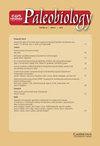Sr/Ca和Ba/Ca比值支持瑞典哥特兰志留系牙形石群落的营养分配
IF 2.7
2区 地球科学
Q2 BIODIVERSITY CONSERVATION
引用次数: 4
摘要
摘要牙形石是一个高度多样化和丰富的脊椎动物群,其化石发现于世界各地的古生代和三叠纪海洋地层。它们生活在从泻湖到公海的各种环境中,并以各种各样的牙齿形态为代表。牙形石可能填充了许多不同的生态位,并在泥盆纪之前代表了相当大比例的nekton。尽管如此,人们对牙形石的营养生态学知之甚少。虽然形态多样性表明牙形石群落中存在复杂的营养结构,但几乎没有证据支持牙形石之间的饮食生态位划分。我们使用瑞典哥特兰志留纪地层组合的牙齿元素中保存的Sr/Ca和Ba/Ca比率,检验了单个牙形石分类群占据不同营养生态位的假设。Sr/Ca和Ba/Ca在脊椎动物骨骼组织中的变化取决于营养定位,尽管生物和环境条件会影响这些比率。通过检查热带表海的整个牙形石群落,并使用热电离质谱法测量大多数大都市分类单元(Ozarkodina confluens)中的锶同位素比率,将环境影响降至最低。还使用微探针分析分析了牙形石特有的组织白质的组成,发现Sr浓度明显低于周围的层状组织,这表明在分析牙形石的地球化学数据时应考虑分类单元特定的组织学。排除白质含量变化较大的分类单元,结果表明,每个分类单元保留了不同的Sr/Ca和Ba/Ca比率,重叠有限,表明营养定位存在差异。本文章由计算机程序翻译,如有差异,请以英文原文为准。
Sr/Ca and Ba/Ca ratios support trophic partitioning within a Silurian conodont community from Gotland, Sweden
Abstract. Conodonts were a highly diverse and abundant vertebrate group whose fossils are found in marine Paleozoic and Triassic strata around the world. They inhabited environments ranging from lagoons to open oceans and are represented by a wide variety of dental morphologies. Conodonts may have filled many different ecological niches and represent a significant proportion of nekton before the Devonian. Despite this, very little is known about trophic ecology of conodonts. While morphological diversity suggests a complex trophic structure within conodont communities, there is little evidence to support dietary niche partitioning among conodonts. We tested the hypothesis that individual conodont taxa occupied different trophic niches, using Sr/Ca and Ba/Ca ratios preserved in the dental elements of assemblages from Silurian strata of Gotland, Sweden. Sr/Ca and Ba/Ca have been shown to vary in vertebrate skeletal tissues depending on trophic positioning, although biological and environmental conditions can affect these ratios. Environmental influences were minimized by examining entire conodont communities from a tropical epeiric sea and by measuring strontium isotope ratios using thermal ionization mass spectrometry in the most metropolitan taxon (Ozarkodina confluens). Composition of white matter, a tissue unique to conodonts, was also analyzed using microprobe analysis, revealing significantly lower Sr concentrations than in surrounding lamellar tissue, suggesting taxon-specific histology should be considered when analyzing conodonts for geochemical data. Excluding taxa with highly variable quantities of white matter, the results show that each taxon preserves different Sr/Ca and Ba/Ca ratios with limited overlap, indicating variation in trophic positioning.
求助全文
通过发布文献求助,成功后即可免费获取论文全文。
去求助
来源期刊

Paleobiology
地学-古生物学
CiteScore
5.30
自引率
3.70%
发文量
38
审稿时长
>12 weeks
期刊介绍:
Paleobiology publishes original contributions of any length (but normally 10-50 manuscript pages) dealing with any aspect of biological paleontology. Emphasis is placed on biological or paleobiological processes and patterns, including macroevolution, extinction, diversification, speciation, functional morphology, bio-geography, phylogeny, paleoecology, molecular paleontology, taphonomy, natural selection and patterns of variation, abundance, and distribution in space and time, among others. Taxonomic papers are welcome if they have significant and broad applications. Papers concerning research on recent organisms and systems are appropriate if they are of particular interest to paleontologists. Papers should typically interest readers from more than one specialty. Proposals for symposium volumes should be discussed in advance with the editors.
 求助内容:
求助内容: 应助结果提醒方式:
应助结果提醒方式:


